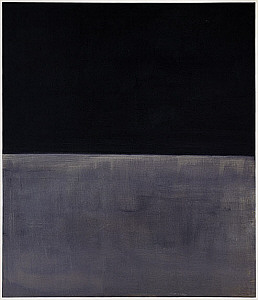The darkness here contrasts with the brightness of other pieces that he produced across his career, and therefore Untitled (Black on Grey) underlines the differing moods that Mark Rothko endured throughout his life. This untitled painting came very close to his death soon after and a lot can be understood about his mindset around that time. Many of his works were dark and depressing around this late stage in his career and contrast massively from what had come before. This final period of Rothko's career, titled his Black and Grey period also came about at a time where his own health was deteriorating physically, as well as mentally.
A close inspection of the canvas will reveal the various tones found within the grey and black blocks, Rothko rarely produced color blocks in a uniform shade. National Gallery of Art, Washington, D.C. holds this painting amongst it's permanent collection, and it is acrylic on canvas, which is standard for this artist. Those making a visit to this institution will also be able to discover original work by other famous names, such as Edvard Munch, Jasper Johns and Robert Rauschenberg, as well as a huge selection of artists from previous centuries and more traditional art movements.
He would go on to create a number of similar paintings, all with this same title between the years of 1969 and 1970. Each iteration would experiment with the tone of grey used, sometimes lighter, sometimes darker. He would also amend the amount of space given to each of the two colours, sometimes allowing one to dominate more of the composition, and other times not. Finally, Rothko would also alter the dimensions of these different variants, with some particularly wide versions, but most were in his more frequent set up of long pieces which could essentially cover the frame of the viewer. He did this in order to allow one to be absorbed into the painting, so long as we stood there long enough. Rothko chose to alter his colour schemes across his career, working with much brighter tones (Orange, Red, Yellow, Untitled (Violet, Black, Orange, Yellow on White and Red)) in the early part of his Color Field work.
Rothko would also design a series of canvases for the Rothko Chapel which would all be displayed together. They would take things a step further, and essentially just use black, though with variations in hue. It is clear that this late period of his career was devoted to darkness, and the emotions that go with that. He has interested in expressing human emotion through his colours and had initially become interested in doing so after witnessing a number of Matisse paintings early in his career. The Frenchman worked within Fauvism for a period and so was clearly focused on the importance of colour, with a number of other famous 20th century painters also considering colour to be perhaps the most significant element of their work and around which all artistic decisions should be based.
"...I'm not an abstractionist, I'm interested only in expressing basic human emotions: tragedy, ecstasy, doom, and so on..."
One can see a real lack of energy and fluidity to this series of black paintings, as the artist pushed closer to his suicide. Many artists have had these periods in their career when darkness dominates - one can remember the early work of Van Gogh, way before the explosion of bright colour that occured once he arrived in the south of France. This variation could also be said to reflect his own state of mind, though he still suffered with mental health issues even after he had started to work with a much brighter palette. Much earlier, there were also the famous Black Paintings series by Goya, in which the artist explained his own negative judgement on humanity itself after a series of problems in society. Rothko's approach was clearly much more abstract and this made the impact even more shocking for those who were used to his previous periods of work.
Once his series of paintings on the theme of black and grey were complete, the artist invited a select crowd to see them in person at his studio. At that time, New York was leading the art world and his connections were excited to see what he had come up with. There was a level of encouragement within this community, though also an inevitable competitiveness. They would come away with different opinions on the meaning of this series, with some considering lunar influences, whilst others contemplated black and white photography. The truth is, his promximity to death is the most likely explanation for the inspiration behind these paintings, whether from his conscious or subconscious mind. It felt like the end in so many ways, with a static nature to these pieces which contrasted markedly from what had gone before.
One tinge of sadness connected to these works is that the visitors to his studio did not entirely laden him with praise upon their unveiling. There were some who actually were unsure as to the seriousness of the artist and it left Rothko feeling undervalued and misunderstood, even within the art community which would normally be receptive to his contemporary ideas. It was a confirmation to him personally that his color field work was only really understood in his own mind, and that the abstract interpretations that he used would not quite get his emotions across to others. He would not be the first artist to struggle to be understood as they wished, but Rothko seemed more emotional and sensitive than others would be and perhaps dwelled on these incidents more than necessary.

